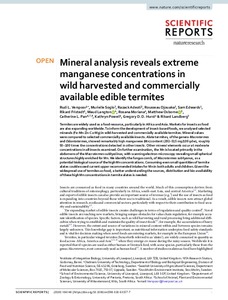| dc.contributor.author | Verspoor, R.L. |
| dc.contributor.author | Soglo, M. |
| dc.contributor.author | Adeoti, R. |
| dc.contributor.author | Djouaka, R. |
| dc.contributor.author | Edwards, S. |
| dc.contributor.author | Fristedt, R. |
| dc.contributor.author | Langton, M. |
| dc.contributor.author | Moriana, R. |
| dc.contributor.author | Osborne, M. |
| dc.contributor.author | Parr, C.L. |
| dc.contributor.author | Powell, K. |
| dc.contributor.author | Hurst, G.D.D. |
| dc.contributor.author | Landberg, R. |
| dc.date.accessioned | 2021-10-14T09:29:19Z |
| dc.date.available | 2021-10-14T09:29:19Z |
| dc.date.issued | 2020 |
| dc.identifier.citation | Verspoor, R.L., Soglo, M., Adeoti, R., Djouaka, R., Edwards, S., Fristedt, R., ... & Landberg, R. (2020). Mineral analysis reveals extreme manganese concentrations in wild harvested and commercially available edible termites. Scientific Reports, 10(1): 6146, 1-9. |
| dc.identifier.issn | 2045-2322 |
| dc.identifier.uri | https://hdl.handle.net/20.500.12478/7273 |
| dc.description.abstract | Termites are widely used as a food resource, particularly in Africa and Asia. Markets for insects as food are also expanding worldwide. To inform the development of insect-based foods, we analysed selected minerals (Fe-Mn-Zn-Cu-Mg) in wild-harvested and commercially available termites. Mineral values were compared to selected commercially available insects. Alate termites, of the genera Macrotermes and Odontotermes, showed remarkably high manganese (Mn) content (292–515 mg/100 gdw), roughly 50–100 times the concentrations detected in other insects. Other mineral elements occur at moderate concentrations in all insects examined. On further examination, the Mn is located primarily in the abdomens of the Macrotermes subhyalinus; with scanning electron microscopy revealing small spherical structures highly enriched for Mn. We identify the fungus comb, of Macrotermes subhyanus, as a potential biological source of the high Mn concentrations. Consuming even small quantities of termite alates could exceed current upper recommended intakes for Mn in both adults and children. Given the widespread use of termites as food, a better understanding the sources, distribution and bio-availability of these high Mn concentrations in termite alates is needed. |
| dc.format.extent | 1-9 |
| dc.language.iso | en |
| dc.subject | Termites |
| dc.subject | Insects as Food |
| dc.subject | Macrotermes |
| dc.subject | Food Security |
| dc.subject | Benin |
| dc.title | Mineral analysis reveals extreme manganese concentrations in wild harvested and commercially available edible termites |
| dc.type | Journal Article |
| cg.contributor.crp | Agriculture for Nutrition and Health |
| cg.contributor.affiliation | University of Liverpool |
| cg.contributor.affiliation | International Institute of Tropical Agriculture |
| cg.contributor.affiliation | Chalmers University of Technology |
| cg.contributor.affiliation | Swedish University of Agricultural Sciences |
| cg.contributor.affiliation | Stockholm Environment Institute |
| cg.coverage.region | Africa |
| cg.coverage.region | West Africa |
| cg.coverage.country | Benin (Dahomey) |
| cg.coverage.hub | Headquarters and Western Africa Hub |
| cg.researchtheme | Nutrition and Human Health |
| cg.identifier.bibtexciteid | VERSPOOR:2020 |
| cg.isijournal | ISI Journal |
| cg.authorship.types | CGIAR and advanced research institute |
| cg.iitasubject | Food Security |
| cg.iitasubject | Food Systems |
| cg.iitasubject | Nutrition |
| cg.journal | Scientific Reports |
| cg.notes | Open Access Journal; Published online: 09 April 2020 |
| cg.accessibilitystatus | Open Access |
| cg.reviewstatus | Peer Review |
| cg.usagerightslicense | Creative Commons Attribution 4.0 (CC BY 0.0) |
| cg.targetaudience | Scientists |
| cg.identifier.doi | https://dx.doi.org/10.1038/s41598-020-63157-7 |
| cg.iitaauthor.identifier | Rousseau Djouaka: 0000-0003-4772-0753 |
| cg.futureupdate.required | No |
| cg.identifier.issue | (1): 6146 |
| cg.identifier.volume | 10 |

